

MUD VS CONCRETE: Which is more Eco-friendly?
We have carbon foot printed two of our projects to compare modern and alternative construction. The modern construction’s CO2 emissions is almost 4 times higher than the alternative construction. We hope that by reading through the results it will encourage people towards Eco-friendly homes
MUD VS CONCRETE
Report by Guillaume Fabre & Sanjay Jain
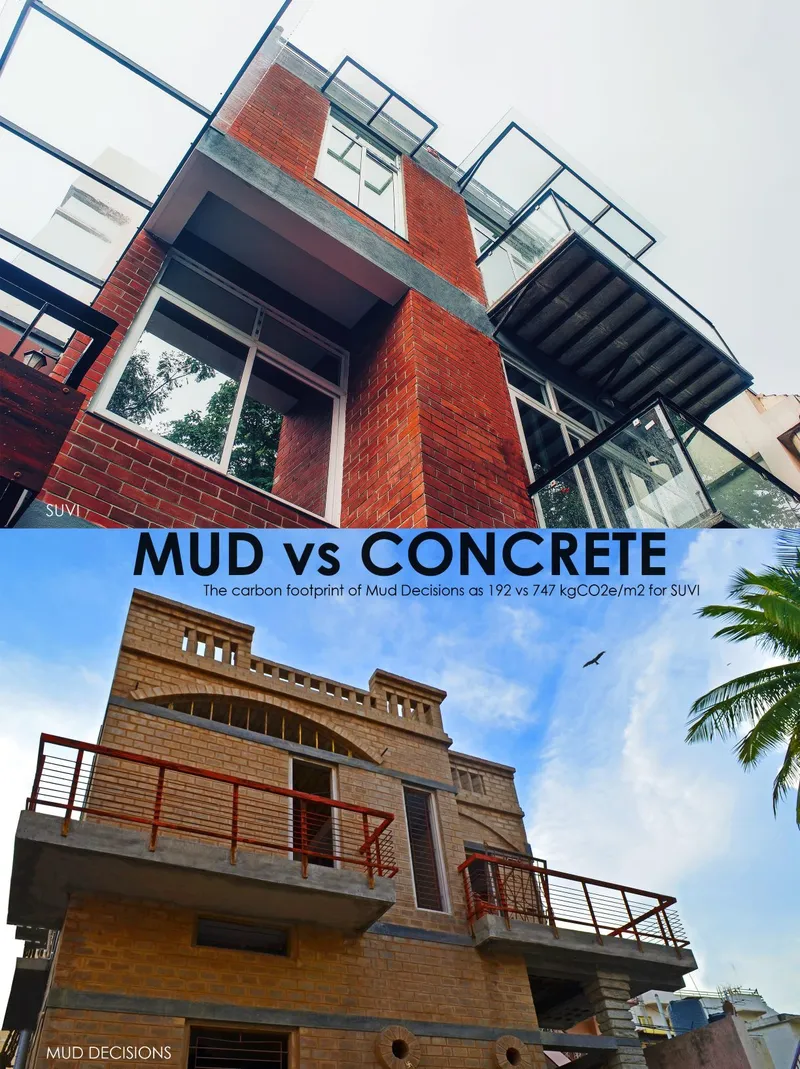
MUD VS CONCRETE: Comparison of carbon footprint of Mud Decision is 192 vs 747 KgCO2e/Sq.m for SUVI
Featured in Design Detail Magazine
BUILDING AND CLIMATE CHANGE
Buildings alone are responsible for 38% of all human Green House Gases (GHG) emissions (20% residential, 18% commercial). It is the industrial sector which contributes the most to Climate Change. Low-carbon Buildings (LCB) are buildings designed and constructed to release very little or no carbon at all during their lifetime. So by definition, a LCB is a building which emits significantly less GHG than regular buildings.
Low-carbon Buildings (LCB) or Eco-friendly Buildings are buildings designed and constructed to release very little or no carbon at all during their lifetime. So by definition, a LCB is a building which emits significantly less GHG than regular buildings. There is no emissions threshold under which a building would qualify as a LCB. But to be genuinely “Climate Change neutral”, a LCB would have to achieve at least 80% GHG reduction compared to traditional buildings. By comparison, a regular building releases about 500 kgCO2e /m2 during its entire lifetime (though it varies a lot, depending on the project type and where it is located).
EMBODIED CARBON: MUD VS CONCRETE CONSTRUCTION
This assessment report illustrates the embodied carbons of two projects Mud Decisions (with Earth Architecture, alternative construction) vs SUVI (Concrete structure, conventional building) by Tropic Responses.
The carbon footprint (whole life embodied carbon of the building) of the Compressed Stabilized Earth Block Building (Mud Decisions project) is 192 kgCO2e/m2 vs 747 kgCO2e/m2 for the Concrete Structure Building (SUVI). We must precise that both projects are located in Bangalore, India.
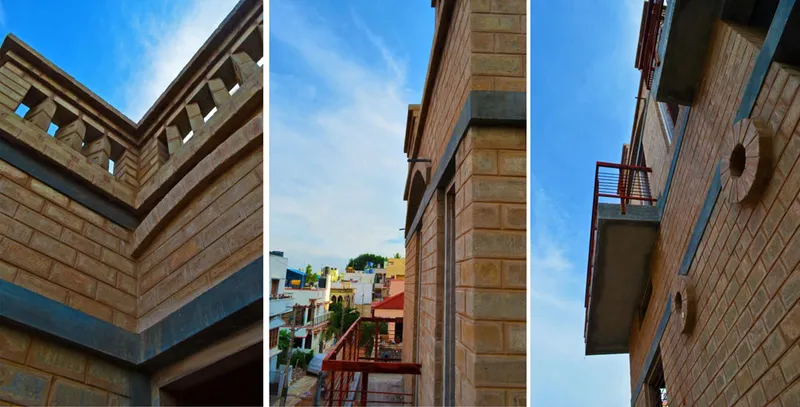
Mud Decisions: CSEB Vault Roof and Exterior lego effect
GOOD EARTH IT IS
It was a fine day when Client walked into our office. How clear he was about the project to be handed over to us. We don’t often get this lucky when a client wants only alternative construction; we saved the ant hill stories and clichéd save earth lullaby. Well we drew up a smart plan with a semi-basement, ground floor, mezzanine and first floor with a total of around 2750 sft. Although the Vaastu rules did some ruin, an interesting split level plan took shape. With good support from our Structural Consultant specific for CSEB construction, we detailed many openings for less or no steel that would be “Ample of Earth Will and Less of Concrete”. Also we were clear about the roofing system with filler, jack arches and brick vaults and the structure was to be load bearing.
Work began at site with precious patience and laborious details. Client had arranged a team that needed to be guided. Stabilized Earth, a good sunshine and how proud we were about the perfect cuboids. Like how a lego interests a child, the bricks made at our own site had a strange “Lego” effect on us. We were continuously trying out patterns to interest as a 2d canvas and which would work well with shadows.
_1553759525594.jpg?fm=png&auto=format&w=800)
Mud Decisions: Building section indicates the alternate construction technique such as jack arch roof, filler slab, arch openings, SSM foundation and etc
1553759561634.jpg?fm=png&auto=format&w=800)
SUVI: Building section indicates the typical RCC structure with RCC columns, beams & slabs with RCC lintel above the openings
Other technicalities followed: all the materials that would reach this site would be sourced within 5 -8 kms. The windows are of Honne wood with Mild Steel as grills for safety, here we scored less. The flooring would be granite, the MS centering for vault roof was to be reused as a railing. And the house finally shaped up with its humble walls, playful arches, rammed earth walls, graphical filler slabs and elated vault roof.
Quite simultaneously about 15 kms away we were executing another house (SUVI) with similar plot size in BTM layout. Here the consensus was for concrete blocks, regular RCC frame, UPVC windows and other finishes with a mammoth carbon foot print. Upon finishing the 2 projects we have drawn a comparative table to internalize and study. A study to reaffirm our belief and to charm and spread the message of aligning oneself to a more Sustainable Way of life.
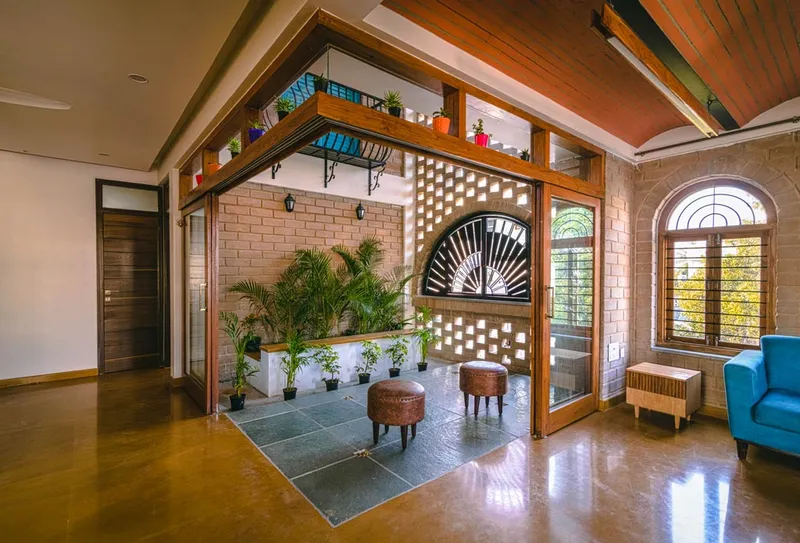
Kochar House: Jack-arch roofing with clay blocks and arch windows with CSEB to avoid lintels beams
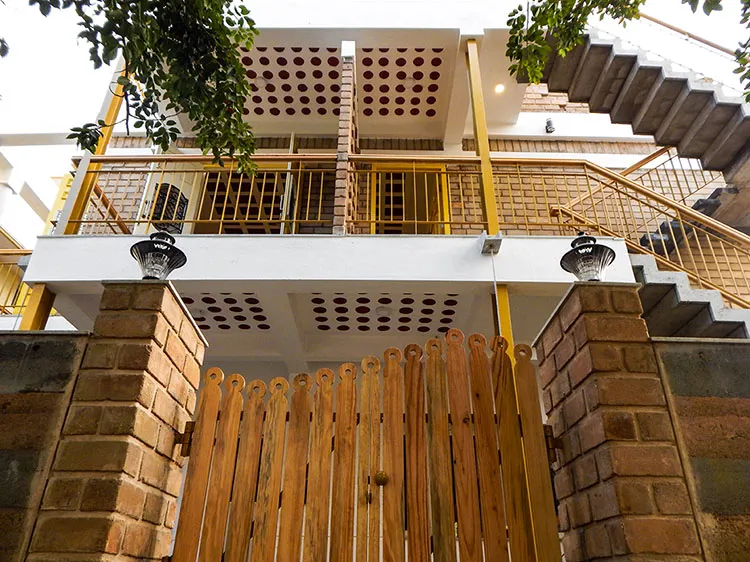
BHOOMI: Pot Filler slabs, Rammed earth compound wall, Cantilevered granite staircase
MATERIALS MANUFACTURING
The total weight of materials used on the MD project is 939 tons compared to 1,095 tons on the SUVI project. When reported per m2 (the SUVI project is about 1/3 bigger than the MD project), that is 4.5 tons on the MD project and 3.4 tons on the SUVI project. This is due to the different nature of materials used: compressed earth blocks on the MD project and reinforced concrete and concrete blocks on the SUVI project. Despite this fact, the emissions associated with the manufacturing of the materialsused on the MD project (114 kgCO2e/m2) are significantly lower than on the SUVI project (543 kgCO2e/m2).
Manufacturing emissions are closely linked to the amount of fossil fuels burned as part of the manufacturing process. In the case of the SUVI project, most of the manufacturing emissions are coming from the production of cement and steel rebar. The manufacturing of 1 kg steel for example is responsible for the release in the atmosphere of approximately 1.4 kg CO2. On the other extreme, the compressed earth blocks (CEB) used on the MD project are virtually “zero carbon” since they are pressed by hand.
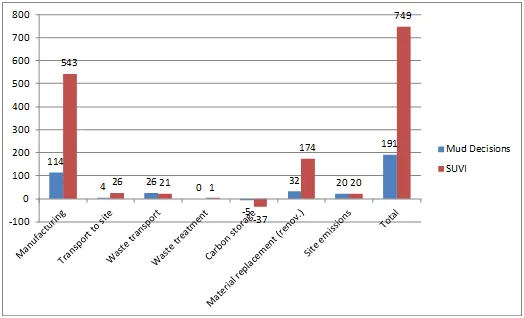
MATERIALS TRANSPORT
The emissions associated with the transport of materials to the project site depend on 3 factors: the weight of the materials, the distances travelled, and the type of transport vehicle. On the SUVI project, most of the materials are transported by truck over distance averaging 11 km. On the MD project, the CEB are manufactured on-site meaning that there are no transport emissions associated with this material. This explains why the materials transport missions on the MD project are significantly lower (4 kgCO2e/m2) than on the SUVI project (26 kgCO2e/m2).
WASTE TRANSPORT
After 50 years, it is anticipated that the MD and SUVI buildings will be deconstructed and the deconstruction waste will be land filled, incinerated, or recycled. It is quite difficult to predict what will be the waste disposal practices in the region where the projects are located 50 years from now. The assessment calculations have been done assuming that all the deconstruction waste will be transported by heavy truck over a distance of 30 km. As indicated previously, the total weight of the materials on the MD project being higher than on the SUVI project, the waste transport emissions are higher on the MD project (26 kgCO2e/m2) than on the SUVI project (21 kgCO2e/m2).
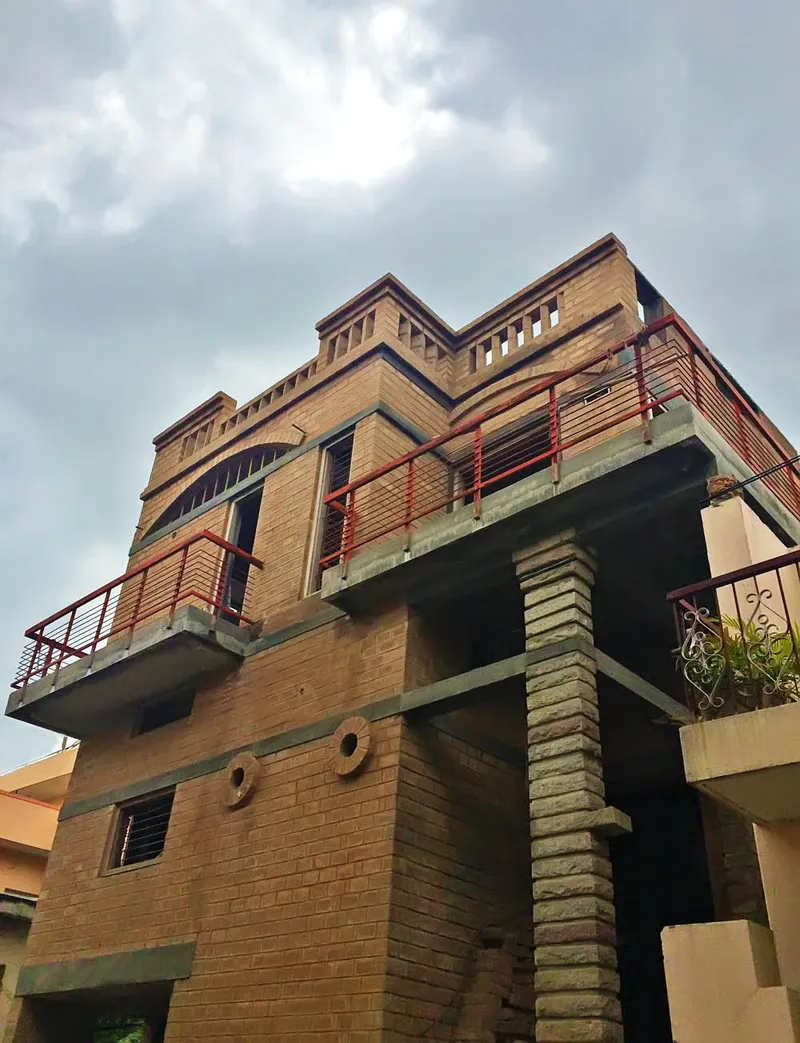
_1553760170260.jpg?fm=png&auto=format&w=800)
WASTE TREATMENT
The waste treatment emissions on both the MD and SUVI projects are relatively small (about 1 kgCO2e/m2). This is mainly due to the fact that the materials used on both projects are mostly inert materials such as CEB, concrete, steel, etc. Regardless of the way in which they are disposed of, these materials do not emit CO2 during this phase of their lifecycle. The only two materials that are susceptible of emitting large amount of CO2 during disposal are plastics (when burned) and wood. These materials are present in very small quantities on the MD and SUVI projects.
CARBON STORAGE
On the MD and SUVI projects, carbon storage is mainly associated with cement (and wood in a lesser extent). Actually, cement is a material that has the property of absorbing atmospheric CO2 throughout its life via a chemical process called carbonation. This phenomenon is limited to the surface of the concrete elements and is generally not complete but it cannot be considered as negligible. 1 kg of cement for example is roughly capable of reabsorbing about 80 gCO2 over 100 years. A large quantity of cement is used on the SUVI project, either in concrete or concrete blocks. This is why the carbon storage on the SUVI project (-37 kgCO2e/m2) is significantly higher than on the MD project (-5 kgCO2e/m2).
1553760264264.png?fm=png&auto=format&w=800)
PROJECT DETAIL
CONCLUSION
All materials have pros and cons when it comes to climate change mitigation. Also the region where the project is located influences greatly the carbon footprint of a building project (for example wood is probably a more adapted building material in Canada than Egypt). This being said, the assessment of the GHG emissions of the MD and SUVI projects demonstrates that earth used as CEB is a particularly interesting “low-carbon” material in India and should whenever possible be preferred over reinforced concrete.




